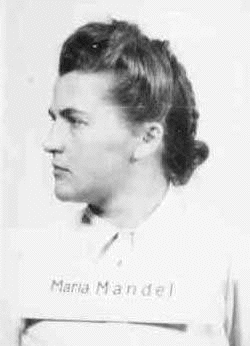Maria Mandl (Maria Mandl)

Maria Mandl was born in Münzkirchen, Upper Austria, then part of Austria-Hungary, the daughter of a shoemaker. After the Anschluss by Nazi Germany, Mandl moved to Munich, and on 15 October 1938 joined the camp staff as an Aufseherin at Lichtenburg, an early Nazi concentration camp in the Province of Saxony where she worked with fifty other SS women. On 15 May 1939, she, along with other guards and prisoners, were sent to the newly opened Ravensbrück concentration camp near Berlin. She quickly impressed her superiors and, after she had joined the Nazi Party on 1 April 1941, was elevated to the rank of a SS-Oberaufseherin in April 1942. She oversaw daily roll calls, assignments for Aufseherinnen and punishments such as beatings and floggings. On 7 October 1942, Maria Mandl was assigned to the Auschwitz II Birkenau camp in German-occupied Poland where she succeeded Johanna Langefeld as SS-Lagerführerin, a female commandant under (male) SS-Kommandant Rudolf Höß. As a woman she could never outrank a man,[citation needed] but her control over both female prisoners and her female subordinates was absolute. The only man Mandl reported to was the commandant. She controlled all the female Auschwitz camps and female subcamps including at Hindenburg, Lichtewerden and Raisko.
Maria Mandl took a liking to Irma Grese, whom she promoted to head of the Hungarian women’s camp at Birkenau. According to some accounts, Mandl often stood at the gate into Birkenau waiting for an inmate to turn and look at her: any who did were taken out of the lines and never heard from again. At Auschwitz, Mandl was known as The Beast, and for the next two years she participated in selections for death and other documented abuses. She signed inmate lists, sending an estimated half a million women and children to their deaths in the gas chambers at Auschwitz I and II. For services rendered, Mandl was awarded the War Merit Cross 2nd class. In November 1944, she was assigned to the Mühldorf subcamp of Dachau concentration camp and Elisabeth Volkenrath became head of Auschwitz, which were liberated in late January 1945. In May 1945, Mandl fled from Mühldorf into the mountains of southern Bavaria to her birthplace, Münzkirchen. The United States Army arrested Mandl on 10 August 1945. Interrogations reportedly revealed her to be highly intelligent and dedicated to her work in the camps. She was handed over to the People’s Republic of Poland in November 1946, and in November 1947 she was tried in a Kraków courtroom in the Auschwitz Trial and sentenced to death by hanging. Stanisława Rachwałowa (a Polish survivor of Auschwitz who was an inmate under Mandl’s administration and, after the war, was arrested by Poland’s post-war communist authorities as an “anti-communist activist”) was imprisoned in the cell next to Maria Mandl and Therese Brandl. Rachwałowa was proficient enough in German to interpret for the wardens. She stated that the last time she and the two German war criminals met – after they had been sentenced to death and shortly before their executions took place – both had asked her for forgiveness. Mandl was hanged on 24 January 1948, aged 36. Brandl was hanged on 28 January 1948, aged 45.
Born
- January, 10, 1912
- Münzkirchen, Austria-Hungary
Died
- January, 24, 1948
- Kraków, Poland
Cause of Death
- execution by hanging
Other
- body donated to medical science

